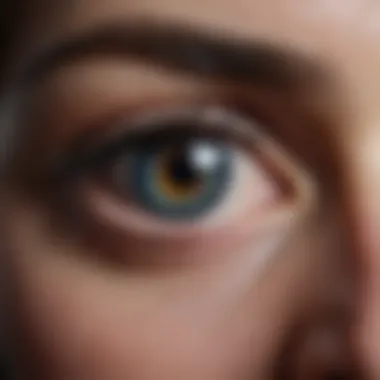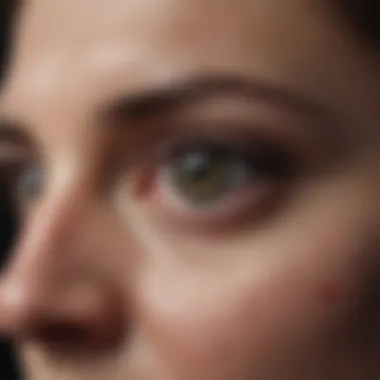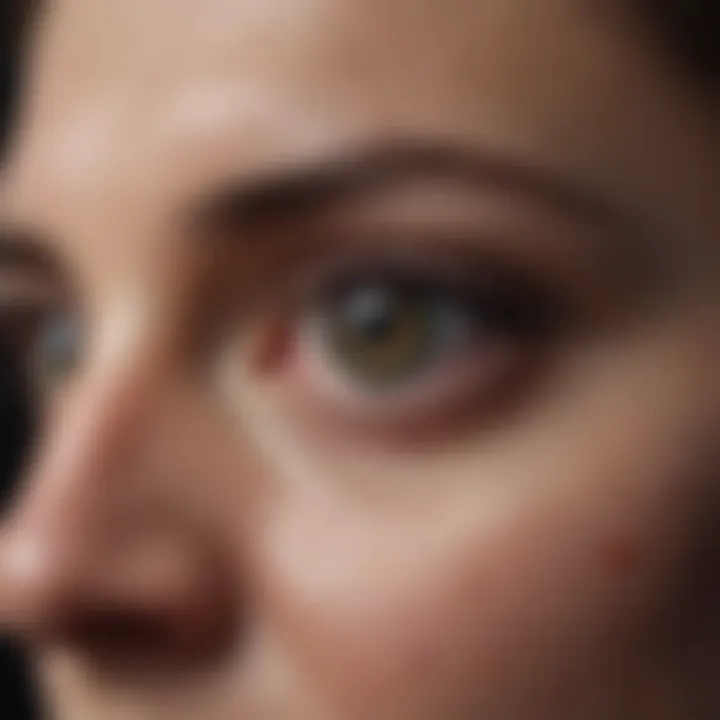Understanding Depression in the Eyes: A Comprehensive Exploration


Intro
Depression is a complex mental health condition that often manifests in various physical and emotional ways. This article focuses specifically on how depression can be observed through the eyes. The eyes, often called the mirror of the soul, reflect a lot about a person's internal state. They do not just indicate joy or sadness; they can reveal deeper emotional struggles, such as those found in depression.
Understanding the connection between ocular expression and mental well-being can offer valuable insights for students, researchers, educators, and professionals. By analyzing the anatomy of the eye and how it relates to emotional states, we can gain a clearer perspective on how psychological distress impacts physical appearance.
Through this exploration, we aim to discuss the physiological changes that occur in the eyes during depressive episodes, as well as the broader implications for mental health treatment. In particular, we will examine the structures of the eye, such as the irises and eyelids, and their alterations in response to mental health challenges.
Additionally, we will delve into the societal perceptions of these changes, aiming to reduce stigma and promote better understanding. This foundational knowledge will pave the way for deeper discussions on the implications of our findings in real-world scenarios and future research directions.
Prelude to Depression in the Eyes
The issue of mental health is often abstract and difficult to convey. However, one area where it manifests vividly is through the eyes. The phrase "the eyes are the window to the soul" holds a certain truth, especially when we explore how depression can influence eye appearance and overall facial expression. This article will highlight the intricate relationship between ocular health and mental well-being, presenting a comprehensive look at how emotional states shine through our eyes.
Depression affects individuals in diverse ways. Understanding its impact on the eyes is crucial not just for mental health professionals but for anyone interested in the interplay between emotion and physical appearance. Recognizing the signs of distress in the eyes can facilitate timely intervention and support.
Defining Depression
To understand how depression manifests in the eyes, we first need a clear definition. Depression is more than fleeting sadness. It is a pervasive condition characterized by persistent feelings of hopelessness, loss of interest, and emotional numbness. This mental state influences how individuals perceive themselves and interact with the world, ultimately affecting various physical aspects, including the appearance of the eyes.
The signs of depression can range from subtle to prominent. Common symptoms include:
- Fatigue
- Changes in sleep patterns
- Mood swings
- Difficulty concentrating
These symptoms not only affect mental health but also leave marks on physical appearance. The eyes can become dull or lifeless, perhaps leading to a noticeable difference in how others perceive those who are struggling.
Link Between Mental Health and Physical Appearance
There exists a profound link between our mental state and how we present ourselves physically. The condition of one’s eyes can serve as an indicator of underlying psychological distress. When individuals experience depression, they may display specific ocular symptoms such as:
- Red or puffy eyes
- Dark circles
- A lack of brightness in the iris
These features are often driven by complex interactions between emotional states and physiological responses. Stress, for instance, can lead to fatigue which in turn manifests in the eyes. Negative feelings can result in poor sleep, contributing to a tired and haggard appearance.
In summary, taking heed of the connection between mental health and physical appearance is crucial. Not only does it help in identifying signs of distress, but it also fosters empathy and understanding in social interactions. Recognizing changes in eye appearance can serve as a cue to look deeper into one’s mental well-being. As we continue through this exploration, we will uncover more detailed aspects of how emotions affect our ocular health, and vice versa.
The Anatomy of the Eye
Understanding the anatomy of the eye is vital for grasping how depression can manifest physically. The eye's structures are not only essential for vision but also reflect emotional and psychological states. Delving into the anatomy of the eye provides insights into the connection between our mental health and what can be observed in our eyes. Such knowledge helps in recognizing how signs of mental distress may be closely linked to physical indicators.
Outer Structures of the Eye
The outer structures of the eye include the eyelids, eyelashes, and the conjunctiva. Each of these components plays a significant role in protection and function. Eyelids serve as a barrier against foreign particles and help in tear distribution. When a person is depressed, one may observe changes in these structures; for instance, tired or droopy eyelids can signal lack of sleep or fatigue often associated with depression.
In the emotional context, the eyes can portray various feelings, from joy to despair. Hence, the outer appearance of the eyes is significant. Changes in the outer appearance can provide valuable clues regarding an individual's emotional state. Loss of luster in the eyes or strained eyelids may indicate underlying mental health issues.
Function of the Iris


The iris is another critical part of the eye, primarily responsible for controlling the amount of light that enters. It regulates the pupil size, influencing how well we see in different lighting conditions. However, the iris is also an emotional canvas. Variations in the iris colors or its reaction to light can reflect physiological responses triggered by emotions. In moments of stress, for example, the pupils may dilate or constrict dramatically based on the situation.
Psychologically, the iris can communicate emotions we may not articulate verbally. Depressed individuals might present with a constant dilated appearance, reflecting a lack of energy and hydration or revealing their ongoing mental struggles. Therefore, examining the function of the iris not only emphasizes its biological role but also how it can mirror psychological states.
Signs of Depression in the Eyes
Understanding the signs of depression in the eyes is crucial for multiple reasons. First, the eyes often serve as a window into a person's emotional and mental state. A careful examination of the eyes can reveal underlying mental health issues, making it a key focus for professionals in psychology and ophthalmology alike. These signs can encompass both physical manifestations and changes in expression that may be evident to observant individuals. Recognizing these indicators not only aids in early identification of depressive states but also supports comprehensive treatment approaches directed at both the mind and body.
Physical Indicators of Mental Distress
Depression manifests in several physical indicators related to the eyes. These indicators are often subtle, yet they can significantly reflect one’s internal emotional turmoil. Commonly noted signs include:
- Dark Circles or Puffiness: Tiredness and poor sleep associated with depression may lead to dark circles under the eyes or puffiness.
- Glassiness or Lack of Luster: Eyes may appear dull or glazed, lacking their usual vibrance.
- Twitching or Involuntary Movements: Muscle tension from stress can result in twitches around the eyelids.
These indicators can signal emotional distress to observers, prompting potential conversations about mental health. They serve as nonspecific symptoms that illustrate an individual's internal struggle, which might be overlooked in a general social environment.
Common Ocular Symptoms in Depressed Individuals
Several ocular symptoms can accompany depression, linking emotional well-being to visual health. Among the notable symptoms are:
- Dry Eyes: Depression can reduce the motivation to maintain adequate hydration and eye care, leading to dry or irritated eyes.
- Difficulty Focusing: Concentration issues often associated with depression can result in difficulty focusing visually.
- Photophobia: Increased sensitivity to light can occur as a somatic response to stress and anxiety, often seen in depressed individuals.
Notably, these ocular symptoms can often be interconnected and indicative of broader mental health issues. Recognizing them can lead to significant discussions about mental health care.
Understanding these signs facilitates a more holistic approach to addressing mental health. By correlating physical signs with psychological states, we can better appreciate the relationship between eye health and emotional well-being.
How Emotions Affect Eye Health
Understanding how our emotions impact eye health is essential. The eyes do not only serve as sensory organs but also act as windows to our mental states. Significant emotional distress can reflect in our eyes, creating a visible connection between mental health and ocular appearance. Conditions such as stress, anxiety, and depression can alter eye function and appearance, leading to ramifications that extend beyond vision.
Impact of Stress on Vision
Stress can have profound effects on vision, often leading to symptoms that are both physical and emotional. When an individual is under stress, the body produces heightened levels of cortisol, a hormone that can temporarily affect eye health. Several studies indicate that stress can lead to blurriness, light sensitivity, and dry eye syndrome. These physical manifestations can be alarming and may exacerbate underlying mental health issues.
- Blurry Vision: Increased tension can lead to difficulties in focusing, which may cause temporary visual impairments.
- Light Sensitivity: Stress can result in heightened sensitivity to light, making it uncomfortable for individuals in bright environments.
- Dry Eye Syndrome: Emotional strain can reduce the blink rate, leading to dryness and irritation, further complicating eye health.
Caring for one’s eyes becomes crucial when dealing with stress. Regular breaks from screen time and ensuring proper hydration can alleviate some of these stress-related symptoms.
Psychosomatic Responses in the Eyes
The concept of psychosomatic responses in the eyes refers to how psychological states manifest as physical symptoms within the ocular region. This phenomenon is a testament to the intricate relationship between mind and body. When one experiences depression or anxiety, it can trigger a range of ocular responses that are not merely coincidental.
- Dark Circles: Fatigue often associated with mental health struggles can cause dark circles under the eyes, giving a tired appearance.
- Redness: Stress or anxiety may lead to dilated blood vessels in the eyes, contributing to a reddened look.
- Squinting or Tension: Individuals may squint more often due to stress or worry, leading to strain that can create discomfort.
Psychosomatic responses demonstrate the need for an integrated approach to eye health and mental wellness. The interplay between emotional state and ocular health highlights that caring for mental health can positively affect physical appearance, particularly in the eyes.
"The eyes communicate emotions that words cannot, often revealing deeper truths about one’s mental state."


This section underscores the importance of recognizing how emotions, particularly stress and psychosomatic responses, manifest in eye health. Awareness can guide individuals to pursue both emotional and ocular care, creating a holistic approach to well-being.
Psychological Interpretations
The psychological interpretations surrounding the eyes are critical in understanding how emotional states can be perceived and how they affect interpersonal dynamics. The eyes often serve as a window to mental health, reflecting not just the emotional landscape of the individual but also influencing how others perceive them. This section will explore key elements related to the cognition behind eye appearance, as well as societal perceptions that can lead to misunderstandings about mental health.
Cognitive Behavioral Aspects of Eye Appearance
Cognitive behavioral approaches emphasize the connection between thoughts, feelings, and behaviors. In the context of eye appearance, this interplay manifests in various ways. For example, an individual suffering from depression may exhibit certain physical traits such as bloodshot eyes or droopy eyelids. These visual indicators can reinforce negative self-perceptions and contribute to a cycle of despair.
Research indicates that individuals may hold specific beliefs about how their emotional states are reflected in their appearance. Such beliefs can influence their confidence levels and social interactions. When someone perceives their eyes as reflecting sadness or hopelessness, this can exacerbate feelings of anxiety or isolation. Conversely, positive cognitive restructuring can lead individuals to reinterpret their appearance and emotional state, creating a more affirmative self-view. This realization can encourage a healthier relationship with their mental health and appearance.
Societal Perceptions and Misinterpretations
The societal interpretation of eye appearance holds significant implications for individuals with mental health disorders. It is essential to recognize that the eyes can carry a social stigma; bloodshot, tired, or otherwise altered eyes can lead others to make unfounded assumptions. These assumptions might label an individual as lazy or disinterested, rather than considering the deeper mental health issues at play.
Often, the eyes serve as one of the first points of judgment in social contexts. Misinterpretation may lead to derogatory comments or avoidance, further isolating those affected. Awareness of these dynamics allows for a more compassionate understanding of how eye appearance can mislead both the individual and the observer. It fosters a dialogue about mental health that encourages understanding, rather than superficial judgment.
"The eyes can reveal intricate details about a person's mental state, yet they are often misunderstood, leading to a cycle of stigma and isolation."
By examining psychological interpretations of eye appearance, one gains valuable insights into the complexities of mental health. Understanding these interactions not only aids individuals in managing their conditions but can also educate society about the nuances of depression and its visual manifestations.
Major Mental Health Disorders and Their Ocular Effects
Mental health disorders have a significant impact on individuals, often manifesting in diverse and complex ways. Among these disorders, depression and anxiety are two of the most prevalent, affecting millions globally. The eyes, often referred to as the "windows to the soul," can reveal a lot about a person's emotional state. This section explores how major mental health disorders specifically influence ocular health, revealing the intricate connection between mental and physical well-being.
Understanding the ocular effects of mental health disorders contributes to a holistic approach to treatment. Recognizing these signs can aid in detecting underlying issues earlier, potentially leading to improved mental health outcomes.
Depression: Types and Symptoms
Depression is not a monolithic condition but rather encompasses various types, each presenting unique symptoms. Major depressive disorder, persistent depressive disorder, and atypical depression are some forms. Symptoms can include, but are not limited to:
- Fatigue or low energy
- Difficulty concentrating
- Changes in sleep patterns
- Altered appetite
- Irritability
- Feelings of hopelessness
Physically, symptoms are often reflected in the eyes. Individuals with depression may exhibit reduced brightness or clarity in their gaze. There may also be changes in the iris, such as altered pigmentation or simply a dull appearance. The eyelids may appear heavier, often leading to a look of tiredness or fatigue. Such changes are not just superficial; they can reflect deeper emotional distress influencing an individual’s overall demeanor.
Anxiety and its Visual Signatures
Anxiety is another prevalent mental health disorder, often marked by persistent worry and fear. This condition can also leave visible imprints on a person's eyes. Common symptoms include:
- Dilated pupils
- Frequent blinking or eye twitching
- Tension in facial muscles
The dilated pupils can indicate heightened arousal, often associated with stress or fear. Constant blinking or twitching can signify restlessness or nervousness. Additionally, individuals may experience fatigue around the eyes due to straining to focus, exacerbating visual discomfort.
The connection between these symptoms and mental health highlights the importance of observing ocular signs during mental health assessments. Eye care professionals can serve a pivotal role in recognizing these signs and fostering interdisciplinary approaches that incorporate both mental and ocular health.
The Role of Eye Care in Mental Health Treatment


The connection between eye care and mental health is often overlooked, yet it holds substantial importance. Addressing eye health signifies more than just maintaining visual acuity. The eyes can serve as indicators of mental distress, and this link presents a unique opportunity to enhance mental health treatments. By integrating eye care into the mental health treatment landscape, we can better address both physiological and psychological needs of individuals.
Regular eye exams are vital in spotting both physical and emotional concerns. Patients can discover symptoms linked to mental health issues through careful observation of their eye conditions. This proactive approach is crucial, particularly for those facing depression or anxiety.
Importance of Regular Eye Exams
Frequent eye examinations are essential for several reasons:
- Early Detection of Symptoms: Many ocular conditions can manifest as a result of emotional distress. Fatigue, dry eyes, and eye strain are common signs that can reflect underlying mental health issues. Regular check-ups may catch these signals early before they escalate.
- Monitoring Changes: Emotional states can lead to fluctuations in vision or even eye health. Regular visits enable careful tracking of these changes. This consistent monitoring can provide insights into how a person’s mental well-being is influencing their eye health.
- Holistic Approach to Health: By including eye care in overall health assessments, practitioners can provide a more comprehensive treatment plan. Understanding the interplay between mental health and eye conditions encourages a more nuanced approach to therapy and healing.
Integrative Approaches in Eye Care and Therapy
The integration of eye care within mental health treatment can take various forms:
- Collaborative Practices: Mental health professionals and optometrists can work together to share information. This collaboration can enhance treatment effectiveness. Share insights on how visual symptoms correlate with emotional well-being.
- Therapeutic Interventions: Techniques such as vision therapy could aid those dealing with anxiety or stress disorders. Calming strategies during treatments can alleviate eye-related symptoms while providing emotional relief.
- Holistic Health Programs: Developing programs that target both mental and ocular health can be beneficial. Practitioners can implement mindfulness practices that include focusing techniques designed to relieve stress and simultaneously support eye health.
- Patient Education: Informing patients about the potential impacts of their mental wellness on eye health can empower them. Understanding this relationship encourages individuals to seek help proactively, thus enabling preventive care.
Integrating eye care into mental health treatment plans can foster a more comprehensive understanding of well-being.
Research Trends in Ocular and Mental Health
The intersection of ocular health and mental well-being is gaining recognition in medical and psychological research. Understanding how mental health disorders, such as depression, manifest through ocular indicators provides significant insights into holistic treatment approaches. The exploration of this topic is vital as it allows for a more comprehensive understanding of mental health conditions, beyond just their psychological symptoms. It also encourages the integration of eye health evaluations into mental health treatment protocols.
Current Findings in the Field
Recent studies have shown several links between visual symptoms and mental health issues. One notable finding is that individuals suffering from depression may exhibit specific physical changes in their eyes, such as a lack of luster in the irises, bloodshot sclera, or droopy eyelids. These signs can serve as non-verbal cues to healthcare providers about a patient’s mental state. For instance, a study published in The Journal of Affective Disorders highlighted how changes in eye appearance could indicate the severity of depressive symptoms in patients.
Additionally, ongoing research has focused on the physiological mechanisms that underlie these ocular manifestations. The role of stress hormones, such as cortisol, is a key area of study. Elevated cortisol levels can affect blood flow and tissue health around the eyes, further confirming the mind-body connection. Moreover, ocular disorders like dry eye syndrome have been associated with anxiety and depression, underscoring the need for interdisciplinary approaches in treatment.
Future Directions for Research
Future research should aim to develop a more detailed understanding of the connectivity between ocular signs and various mental health disorders. Efforts could include larger longitudinal studies that follow patients over time, examining how changes in eye health correlate with mental health treatment outcomes. This could potentially uncover critical information about the effectiveness of specific therapies.
Another promising avenue is the advancement of technology, such as the use of artificial intelligence and imaging techniques, to detect subtle ocular changes that may indicate mental distress. This could lead to earlier diagnoses and interventions, ultimately improving patient outcomes.
In addition, exploring the societal stigmas attached to mental health through the lens of ocular health should be prioritized. Understanding how people perceive eye-related physical changes in others could influence the stigma surrounding mental health disorders.
The End
In this article, the connection between eye health and mental well-being is clearly laid out. Understanding this topic is critical because it emphasizes how mental states reflect in our physical appearance, particularly in our eyes. Depression, often seen as a psychological issue, has profound physical manifestations. This understanding can lead to better methods of treatment, benefitting a significant number of individuals who suffer from these overlapping disorders.
Recapitulation of Key Insights
- Depression influences not only mental health but also physical signs visible in the eyes.
- Indicators such as dark circles, drooping eyelids, and an overall lack of luster can hint at emotional distress.
- The anatomy of the eye and how stress affects it provides clarity on the interconnectedness of physical and mental states.
- The role of eye care in treating mental health is highlighted, showcasing how comprehensive care can include examining visual health.
Understanding these aspects encourages a holistic view of treatment strategies, addressing both mental and ocular conditions in unison. When individuals recognize that their eyes can reveal deeper emotional states, they can pursue both psychological and physiological healing more effectively.
Final Thoughts on the Interconnectivity of Eye Health and Mental Well-Being
The relationship between eye health and mental well-being is intricate. Recognizing that mental health issues can manifest as physical changes in the eyes serves as a reminder of the mind-body connection. Attention to eye health is more than just about vision; it plays a crucial role in emotional health as well.
For students, researchers, and professionals in the field, this understanding underscores the importance of interdisciplinary approaches in treatment. Engage with findings in both mental and ocular health to develop better practices and insights.
"The eyes are not just windows to the soul; they are indicators of our mental states."
Mental well-being advocates should prioritize education on this topic. By focusing on the visible signs of mental distress and its implications for ocular health, we can strive toward a future where comprehensive care is the norm. In doing so, we break the stigma surrounding mental health and promote better healing prospects.







